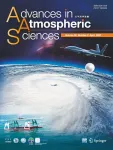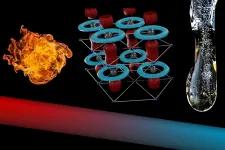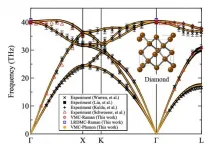(Press-News.org) Nagoya University researchers have identified a gene that plays a crucial role in regenerating neurons of African clawed frog tadpoles, which has an unusually high capacity for nerve regeneration. Their study, recently published in the journal iScience, showed that introducing the gene into mice with spinal cord injury (SCI) led to a partial recovery of their lost motor functions. These findings could contribute to the development of a new therapy for SCI, which often causes a person to experience permanent and severe physical and neurological disabilities.
Repairing spinal cord injuries in humans and other mammals is difficult, partly because of their limited ability to repair and regenerate neural tissues in the spinal cord. In contrast, there are animals with a high capacity for nerve regeneration, such as the African clawed frog. "As a tadpole, it is fully capable of functional recovery after a spinal cord injury," said Drs. Dasfne Lee-Liu and Juan Larrain from the P. Universidad Catolica de Chile in their study, "Genome-wide expression profile of the response to spinal cord injury in Xenopus laevis reveals extensive differences between regenerative and non-regenerative stages," published in 2014.
In this context, the Nagoya University research team conducted a collaborative study with Drs. Lee-Liu and Larrain to identify transcription factors that regulate nerve regeneration in the African clawed frog tadpole, with the aim of inducing regenerative effects in mammals. The team comprehensively analyzed the gene expression profiles of tadpoles in response to SCI, and found that a gene called Neurod4 was expressed predominantly during nerve regeneration. The team thus hypothesized that this gene is a key factor in the regeneration of neural tissues after an injury.
In this study, the team also focused on the fact that in mammals, neural stem cells (known as self-renewing cells) derived from the ependymal cells lining the central canal of the spinal cord are activated and proliferate in the early stage of SCI, although these types of neural stem cells eventually transform into astrocytes -- a type of cell that forms rigid glial scars.
"Taking these things together, we thought that introducing Neurod4 into activated neural stem cells may help regenerate neurons," said Associate Professor Atsushi Natsume of the Nagoya University Graduate School of Medicine, the corresponding author of the study.
To that end, the team conducted experiments in which the Neurod4 gene was introduced to activated neural stem cells in mice just after SCI. The researchers observed that the neural stem cells were successfully converted into neurons and, interestingly, the mice occasionally moved their paralyzed hind legs. Dr. Natsume explained, "Neurod4 introduced into activated neural stem cells facilitates the production of relay neurons, which project to motor neurons of the hind legs. As a secondary effect, glial scar formation was suppressed after the subacute phase of spinal cord injury. This effect allows an environment that was conducive for axons to elongate beyond the injury site and form synapses, thereby improving the motor function of the hind legs."
"Our method is to introduce a neuro regenerative gene directly into neural stem cells that are already present in the spinal cord. This could lessen the problems of rejection and tumor formation, which often occur in conventional stem cell transplantation methods. We believe this study will contribute to the development of new therapeutic approaches to spinal cord injury," he added.
INFORMATION:
The study, "Neurod4 converts endogenous neural stem cells to neurons with synaptic formation after spinal cord injury," was published in the journal iScience on January 20, 2021 at DOI?10.1016/j.isci.2021.102074.
Authors:
Toshiki Fukuoka, Akira Kato, Masaki Hirano, Fumiharu Ohka, Kosuke Aoki, Takayuki Awaya, Alimu Adilijiang, Sachi Maeda, Kuniaki Tanahashi, Junya Yamaguchi, Kazuya Motomura, Hiroyuki Shimizu, Yoshitaka Nagashima, Ryo Ando, Toshihiko Wakabayashi, Dasfne Lee-Liu, Juan Larrain, Yusuke Nishimura1, Atsushi Natsume
About Nagoya University, Japan
Nagoya University has a history of about 150 years, with its roots in a temporary medical school and hospital established in 1871, and was formally instituted as the last Imperial University of Japan in 1939. Although modest in size compared to the largest universities in Japan, Nagoya University has been pursuing excellence since its founding. Six of the 18 Japanese Nobel Prize-winners since 2000 did all or part of their Nobel Prize-winning work at Nagoya University: four in Physics - Toshihide Maskawa and Makoto Kobayashi in 2008, and Isamu Akasaki and Hiroshi Amano in 2014; and two in Chemistry - Ryoji Noyori in 2001 and Osamu Shimomura in 2008. In mathematics, Shigefumi Mori did his Fields Medal-winning work at the University. A number of other important discoveries have also been made at the University, including the Okazaki DNA Fragments by Reiji and Tsuneko Okazaki in the 1960s; and depletion forces by Sho Asakura and Fumio Oosawa in 1954.
Website: http://en.nagoya-u.ac.jp/
Cancer patients generally have a higher thrombotic risk than the population at large. This risk is influenced on the one hand by patient-specific factors and the cancer itself and, on the other, by the cancer treatment, that is to say surgery, radiotherapy, or specific chemotherapeutics, which can increase the risk.
In the last few years, immune checkpoint inhibitors have increasingly been used to treat many different types of cancer. By activating the immune system against the tumour, these drugs improve the prognosis for patients with malignant melanoma, ...
Tropical cyclones -- known as typhoons in the Pacific and as hurricanes in the Atlantic -- are fierce, complex storm systems that cause loss of human life and billions of dollars in damage every year. For decades, scientists have studied each storm, striving to understand the system yet unable to fully measure every intricate variable. Now, the convergence of new observational tools and the launch of an inclusive database may elucidate the innerworkings of tropical cyclones in the Western North Pacific and South China Sea.
Three papers were published in the latest issue of Advances in Atmospheric Science. One paper, led by the Chinese Meteorological Administration (CMA), focuses on a new tropical cyclone database, and the other two, led by The Petrel Meteorological ...
Tokyo, Japan - A research team from the Institute of Industrial Science, The University of Tokyo has conducted a detailed analysis of the uncertainties associated with flood risk modeling at the global scale. They found large uncertainties were mainly associated with runoff data. Flood magnitude is large in wet regions, but uncertainties in flood depth is larger in dry and mountainous regions affected by rare, extreme floods. The results of the study can be used to identify the key areas for improvement in hydrological modeling and improve future predictions of flood risk.
Assessment of the risk of rare and extreme floods is essential ...
A team of Nanyang Technological University, Singapore (NTU Singapore) researchers has designed a 'smart' device to harvest daylight and relay it to underground spaces, reducing the need to draw on traditional energy sources for lighting.
In Singapore, authorities are looking at the feasibility of digging deeper underground to create new space for infrastructure, storage, and utilities. Demand for round-the-clock underground lighting is therefore expected to rise in the future.
To develop a daylight harvesting device that can sustainably meet this need, the NTU team ...
Japan is a country known for its continuous quality improvement (KAIZEN) in manufacturing. Now doctors are bringing this philosophy to the medical field. In pediatric intensive care units (PICU), quality improvement (QI) is needed to ensure complex medical care is provided to critically ill patients in a timely manner.
A research group led by Associate Professor Etsuko Nakagami-Yamaguchi and Graduate Student Yu Inata of the Department of Medical Quality and Safety Science, Osaka City University Graduate School of Medicine, set out to understand and assess the literature describing quality improvement in PICUs.
"Although ...
Researchers from University of Tübingen (Tübingen, Germany) and Ural Federal University (Ekaterinburg, Russia) have developed and experimentally tested new method to understand how the brain builds associations between previously unrelated words. The findings are published in Journal of Neurolinguistics.
The scientists conducted used electroencephalography to measure how the brain responds to the incongruent sentence endings. So, the brain responses to the last word in the phrase "I like my coffee with cream and sugar" have much smaller magnitude as compared to the phrase "I like my coffee with cream and socks". The brain reacts in a similar way to words ...
The protein Asc-1 regulates whether fat-burning beige or fat-storing white adipocytes are formed, which can have an impact on the development of metabolic diseases. This is shown by a current study of the Helmholtz Zentrum München and the German Center for Diabetes Research (DZD). The results open up new approaches to prevent the development of metabolic diseases. The study has now been published in Nature Communications.
Not all fat is the same: there is white, brown and beige adipose tissue *. While white fat cells serve as energy stores, excess energy is burned in brown and beige fat tissue. Too much white fat is considered unhealthy. If the white adipose ...
A thermos bottle has the task of preserving the temperature - but sometimes you want to achieve the opposite: Computer chips generate heat that must be dissipated as quickly as possible so that the chip is not destroyed. This requires special materials with particularly good heat conduction properties.
In collaboration with groups from China and the United States, a research team from TU Wien therefore set out to find the optimal heat conductor. They finally found what they were looking for in a very specific form of tantalum nitride - no other known metallic material has a higher thermal conductivity. In order to be able to identify this record-breaking material, they first had to analyse which processes play a role in heat conduction in such materials at the ...
Ishikawa, Japan - The focus and ultimate goal of computational research in materials science and condensed matter physics is to solve the Schrödinger equation--the fundamental equation describing how electrons behave inside matter--exactly (without resorting to simplifying approximations). While experiments can certainly provide interesting insights into a material's properties, it is often computations that reveal the underlying physical mechanism. However, computations need not rely on experimental data and can, in fact, be performed independently, an approach known as "ab initio calculations". The density functional theory (DFT) is a popular example of such an approach.
For most material ...
A new report is highlighting ways we can fight COVID-19 while indoors during cold weather periods.
At the beginning of the COVID-19 crisis, there was a lack of empirical evidence on the virus's airborne transmission. However, an increasing body of evidence - gathered particularly from poorly ventilated environments - has given the scientific community a better understanding of how the disease progresses. Information on the asymptomatic and pre-symptomatic transmission of the virus strongly supports the case for airborne transmission of COVID-19.
In a study published by the journal Proceedings of the Royal Society A, scientists from the University of Surrey, together with other members of the Royal Society's Rapid Action in Modelling ...







